Sometimes gardening feels like a leisure activity, but sometimes it feels like work: weeds, aphids, gophers, heat waves. At which times I think, Why not just buy all my food at the grocery store? It’s so convenient. You show up any day and choose from all sorts of fresh stuff. Yeah, but . . .
There are a lot of good reasons to persevere in the gardening adventure despite the obstacles of weather and pests and so on. Here are nine that keep dirt under my fingernails:
1. Taste
My friend bought an apricot at the store one day. It was bland, he said. A waste of money. Apricots are notoriously delicate, and in order to get them from a farm to a store shelf, it must withstand a lot of handling. In order to survive that journey they must be picked before they’re ripe, yet apricots don’t sweeten up well if they’ve been picked that early.
On the home tree, our Blenheim apricots are able to become as rich as naturally possible because they need to travel only inches, from a branch to our mouths.
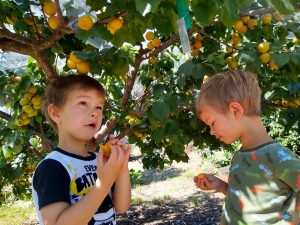
2. Variety
I overheard a man in the grocery store ask the produce manager if they had any more of those “Dinosaur Eggs.” He said his son loved them. Dinosaur Egg is the trade name given to a variety of pluot called Dapple Dandy. We grow a Dapple Dandy tree at home, and we love them too, but there are other even better pluots that never make it to grocery store shelves. Flavor Grenade is one such variety.
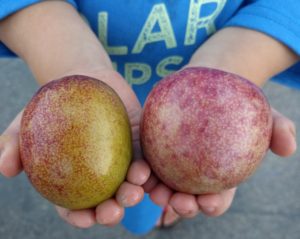
3. Children
Some parents have difficulty getting their kids to eat vegetables at the dinner table, and so do I. Strangely though, they’ll eat raw vegetables in the garden all day long. On their own, they constantly pull carrots, munch on heads of broccoli, and pick peas. I’ve often wondered if children were meant to graze.

(See my post, “Want kids to eat vegetables? Grow them.”)
4. Awareness
Pesticides, herbicides, fungicides. They’re sprayed on crops and injected into the soil on most farms — even certified “organic” farms. (See my post, “What is organic, actually?”) But you don’t know exactly what has been sprayed on the food you buy from a grocery store because supplying that information is not required of farmers or stores. I like to know what I’m eating, however, and especially what my wife and children are eating, and I can only know this if I know my farmer or I grow it myself.
5. Quality
It used to infuriate me to buy a handful of avocados at the store and find upon cutting them open that half were rotten inside. In a fit of such anger I wrote a post titled “Mexican avocados suck”. (In a similar mood, a University of California farm advisor wrote a similar rant here.) On the other hand, rarely is an avocado from the trees in my yard anything but perfect inside. It’s not because I’m a great farmer, it’s just that our avocados don’t need to be trucked and refrigerated and gassed with ethylene and squeezed to death by shoppers.
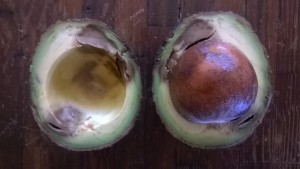
6. Trash
There’s a lot less going to the landfill when food comes out of the garden. When we eat our cherry tomatoes we’re usually standing beside the vines, or we pack them in a Tupperware container so we can eat them as a snack on the road. Buy cherry tomatoes at the store and you buy a plastic clamshell with an absorbent towel at the bottom. Getting the tomatoes from the field to the store requires a bunch more containers. Ever seen the dumpsters behind a grocery store?

7. Cost
I used to assume that growing food at home was good for a host of reasons except saving money, until I took a closer look. At least for some crops, it’s cheaper. (See my posts about the economics of homegrown avocados and the economics of homegrown broccoli.) And do note that homegrown food has all of the costs built in whereas purchased food does not, as most farms and food-production industries are subsidized in various ways with your tax dollars.

8. Dirt
“The soil contributes to the human gut microbiome . . . [and] is a major inoculant and provider of beneficial gut microorganisms,” write the authors of a 2019 paper in the journal Microorganisms. “In recent decades, however, contact with soil has largely been reduced, which together with a modern lifestyle and nutrition has led to the depletion of the gut microbiome with adverse effects to human health.”
Eating food from the grocery store keeps you out of touch with the dirt. Much food sold in grocery stores, including fresh fruits and vegetables, is required by government regulations to have gone through sterilization protocols such as being bathed in a chlorine solution or being irradiated or pasteurized.
I deliberately do not wash every speck of dirt off after I pull up a carrot from my garden to eat.
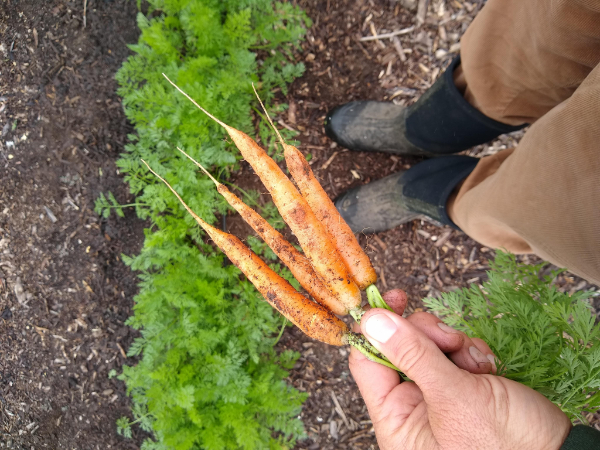
9. Convenience
The convenience of one-stop shopping at a grocery store is undeniable, but there are times when a food garden is convenient too. One day I had planned to make burritos for dinner when I realized that we had no salsa. I walked out the door and picked tomatoes, peppers, a lime, cilantro and oregano. We had onions and garlic stored from the spring harvest. A little chopping and roasting later, I had what I needed.
My hope with this post is to encourage you to grow more of your own and to remind you of some of the ways in which your current efforts at growing food are worthwhile. Your work is virtuous. It makes you and your family healthier, it makes our environment cleaner, and it can save money.
It can also make our neighborhoods more friendly and secure. I interact with many of my neighbors through talking about gardening and sharing plants and produce from our yards. Recently, a neighbor gave me some Surinam cherries. Before that I had given her some Reed avocados.
Let’s keep at it.
All of my Yard Posts are listed HERE
There are no ads on The Yard Posts because of your support. Thanks!

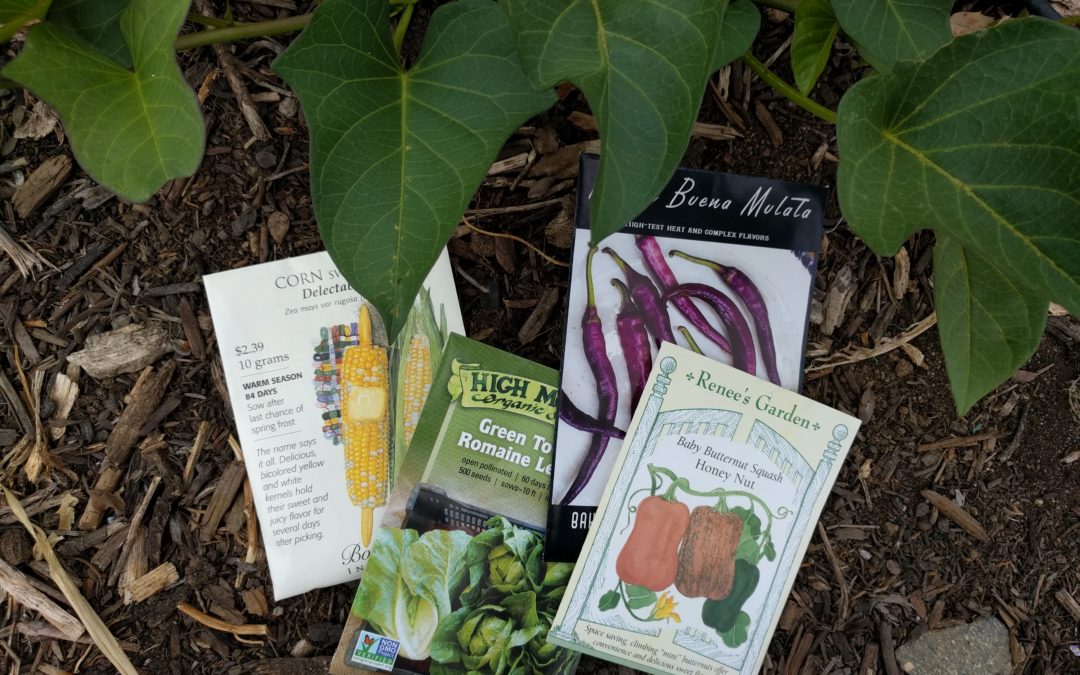


What is your trick for growing blackberries in SoCal? My only berry that thrives are my strawberries. Such a struggle for all others, especially blackberries. BTW, I must agree w/reason #8 on your list. ????
It depends a little on how close to the beach you live. If you’re within about a mile or two, then you can grow them in full sun. But if you’re much farther away, they’ll probably appreciate some shade during the second half of the day.
In my yard, twenty miles from the ocean, blackberries (and raspberries) in full sun end up getting fried in hot afternoon sun. I learned to plant them just to the east of something, for example, my house, a big orange tree, and big oak trees, where they get shade after noon. I learned this from my grandma, who grew amazing boysenberries just east of tall pines and oaks.
That’s how they often grow naturally in Southern California too (yes indeed, we have native cane berries), in partially shaded creek beds or beside big trees. They’re never in full sun, except right close to the beach.
Thanks for liking my view!
I 100% agree, Greg! As a child, on family hiking trips, we would find wild berries growing next to small streams in the San Gabriel mountains. They were always in dappled shade. After scorching more berry plants than I care to count, I finally let that memory guide my planting. I now have a successful (4 year old) boysenberry patch on the north side of my house in Temecula, shaded from the afternoon sun by a Pygmy date palm. The plants are thriving.
This is motivating. Thanks Greg.
Good to hear it’s motivating for you. I started taking notes on this list precisely because I wanted a reminder during discouraging times when I lacked motivation.
Greg – I agree with you wholeheartedly….if you are successful in the garden! I’ve subscribed to multiple CSAs over the last decade or so before I had a garden and have mostly avoided buying veggies & fruits from the grocery store. Just learn to cook what’s in there and get creative with recipes. Now that we had a successful garden first year out I’m excited to grow more and try try again.
Regarding eucalyptus mulch – we received a large dump from Chip Drop (so free) for the front of our property and had I known I would have never allowed eucalyptus which is a fire hazard and in NorCal people are cutting them down everywhere for fire prevention. We’ll stick to other trees!
p.s. Ate your last Reed a couple days ago and shed a tear it was so good and now they’re gone!
“You show up any day and choose from all sorts of fresh stuff“
Options? Yes. Fresh? Um….
Ha! So right. I took a photo of some rotten looking mandarins on a shelf a while back.
Love your articles. I planted what the nursery said it was a cumquat tree. After 5-6 years no fruit. This year a different kind of citrus blossomed. I believe it is a Japanese Trifotiate orange or Poncirus. Looks like a small lemon and taste very bitter. Actually I can’t eat it.
What is it good for? Could it have been grafted? Should I keep it or replace it with a cumquat tree?
Thanks Bob
Hi Bob,
Check these posts: https://gregalder.com/yardposts/beware-of-rootstock-suckers-on-citrus-trees/
https://gregalder.com/yardposts/which-kind-of-citrus-tree-do-i-have/
It’s probably all rootstock and you should either replace it or graft, if you’re adventurous.
Looks to me like the best thing growing in your garden are the kids.
I like that!